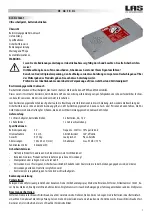
Now, let’s put the 9212 to work. There are several
optional load control strategies available, but a typical
strategy could involve the 9212 recognizing higher pri-
ority loads, such as the dryer, thus cutting back on loads
of less priority, like the heating or cooling loads for a
short period of time, while the higher load or uncon-
trolled load is on. When the dryer turns off, the power it
had been using is channeled back to the heating or
cooling loads, thus maintaining comfort but reducing
peak demand. The end result is that while you have still
used the amount of energy normally called upon by your
lifestyle, this usage has been leveled out to reduce the
peak demand. This is illustrated by Owner B in Figure 1.
How the 9212 Saves
Now that we’ve examined how the 9212 enables you to
use the energy you are accustomed to, but spreads this
usage out by turning off non-critical loads for short
periods of time, let’s look at how this saves you money.
Remember the utility company helps you save by offer-
ing the Demand Rate which is a lower rate per unit of total
power consumed (Kwh). You can save money under this
rate if you control your peak energy usage so as to keep
the corresponding demand charge low.
The following hypothetical example illustrates how the
Energy Sentry 9212 helps you save. Three cases are
presented for a single residence. In all three cases the
total energy consumption is the same. The differences
are in the utility rate structure and whether or not an
Energy Sentry 9212 is installed.
Case I
is an all-electric home billed under the Energy
Rate. This differs from the Demand Rate, in that there is
a higher charge for total energy used. Most homes not
under the Demand Rate are billed under the Energy Rate.
Reference to Table 1 shows a monthly energy use of 3000
Kwh. Although rates vary from utility to utility, the
example electric bill based on actual utility rates for this
energy usage level would be $214.80 with 3000 Kwh
being a typical usage for a high use month.*
Case II
is the same all-electric home billed under the
Demand Rate. In this case, peak energy usage plays an
important part in determining the total bill. Although
energy use peaks will vary from month-to-month, a
typical value for a high-use month might be 18 KW.
Based on a total usage of 3000 Kwh, the example electric
bill based on actual utility rates would be $211.00**.
Compared to Case I, use of the Demand Rate results in
savings of approximately 2% for the same energy usage.
The reason is the demand charge for the high demand
peak offsets the savings on energy costs.
* Based on Black Hills Power Schedule RTE-14 Energy
Rate, effective January 1, 2007. Does not include fuel
cost adjustment and taxes.
3
Different Meters
Demand rates incorporate the use of a special electric
meter which registers not only the total energy con-
sumed, just like the standard watt-hour meter, but also
has a separate needle, dial or a register which records and
indicates the highest average peak energy usage or
demand peak as recorded over a 15, 30 or 60-minute
demand interval (depending on the utility). Once this
demand peak is registered on the meter, a corresponding
demand charge results even if this peak occurred only
once during the billing period.
To benefit from your Energy Sentry 9212 Demand Con-
troller you must have a demand measuring electric meter
and
be billed on a demand billing electric rate from your
utility. Obtain a free booklet or rate sheet from your
power company that describes your electric rate and
how to read your electric meter. We recommend that you
read your metered demand on the day prior to when the
meter is read by the power company, to verify that your
setting matches the meter’s reading.
Where Energy Sentry
9212 Technology Comes In
If it were humanly possible to go through your home
continuously and manually turn off heating or cooling
circuits and major appliances to level out peak demand
whenever necessary, you wouldn’t need an electric
demand controller to take advantage of the demand rate
offered by your utility company. But remember, one slip
in any one demand interval and your utility bill would
reflect a high demand charge.
The 9212 takes over this difficult, continuous burden for
you. The 9212 is one of the most sophisticated products
available for controlling electric peak demand. When
properly used, it can result in average monthly savings
of up to 35% and as much as 50% during heavy-use
months. The sole purpose of the 9212 is to efficiently
allocate electricity usage of electrical loads so that
demand peaks are kept below the level you set without
changing your lifestyle.
How the 9212 Works
The 9212 contains a microprocessor-based computer
which turns certain circuits on and off to keep peak
demand below a limit that you preset. Not all circuits
need to be controlled by the 9212. Circuits controlled
usually include the air conditioner or heat pump, all
heating zones, the dryer, the water heater or any other
load with some thermal storage capacity.
In a typical all-electric home, the morning routine may
involve turning up some thermostats, operating the
range, water heater and other appliances. Normally,
operation of these loads causes a morning peak (such as
that illustrated by Owner A in Figure 1) which registers
on the demand meter.






































